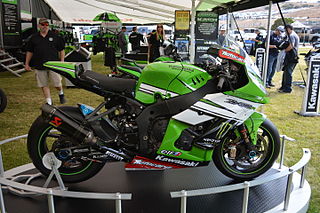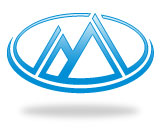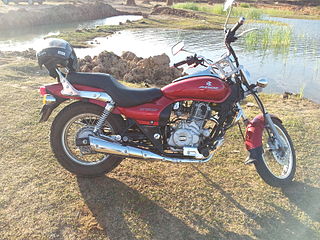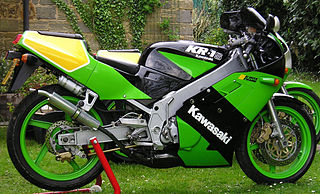
The Honda Magna is a cruiser motorcycle made from 1982 to 1988 and 1994 to 2003 and was the second Honda to use their new V4 engine shared with the VF750S Sabre and a few years later a related engine was fitted to the VF750F 'Interceptor', the later models used a retuned engine from the VFR750F with fins added to the outside of the engine. The engine technology and layout was a descendant of Honda's racing V4 machines, such as the NS750 and NR750. The introduction of this engine on the Magna and the Sabre in 1982, was a milestone in the evolution of motorcycles that would culminate in 1983 with the introduction of the Interceptor V4. The V45's performance is comparable to that of Valkyries and Honda's 1800 cc V-twin cruisers. However, its mix of performance, reliability, and refinement was overshadowed by the more powerful 1,098 cc "V65" Magna in 1983.
The Honda XR series is a range of four-stroke off-road motorcycles that were designed in Japan but assembled all over the world.

The Honda Shadow refers to a family of cruiser-type motorcycles made by Honda since 1983. The Shadow line features motorcycles with a liquid-cooled 45 or 52-degree V-twin engine ranging from 125 to 1,100 cc engine displacement. The 250 cc Honda Rebel is associated with the Shadow line in certain markets.

The Kawasaki Ninja 250R is a motorcycle in the Ninja sport bike series from the Japanese manufacturer Kawasaki originally introduced in 1986. As the marque's entry-level sport bike, the motorcycle has undergone few changes throughout its quarter-century lifetime, having received only three substantial redesigns. In some markets the Ninja 250R has been succeeded by the Ninja 300.

The Kawasaki Ninja ZX-10R is a motorcycle in the Ninja sport bike series from the Japanese manufacturer Kawasaki, the successor to the Ninja ZX-9R. It was originally released in 2004 and has been updated and revised throughout the years. It combines an ultra-narrow chassis, low weight, and radial brakes. In 2004 and 2005 the ZX-10R won Best Superbike from Cycle World magazine, and the international Masterbike competition.

Syarikat Motosikal dan Enjin Nasional Sdn. Bhd, or known as Modenas for short is a Malaysian national motorcycle company producing various small motorcycle models below 400cc targeted for local market and export. The company's headquarters and factory are located at the small town of Gurun, Kedah, Malaysia.

The Vulcan name has been used by Kawasaki for their custom or touring bike since 1984, model designation VN, using mostly V-twin engines ranging from 125 to 2,053 cc.

A motorcycle engine is an engine that powers a motorcycle. Motorcycle engines are typically two-stroke or four-stroke internal combustion engines, but other engine types, such as Wankels and electric motors, have been used.

The Kawasaki Concours, known as the GTR1000 in some markets, is a 1,000 cc sport touring motorcycle manufactured between 1986 and 2006 by Kawasaki. In 2007 it was replaced by the larger displacement Concours 14, also known as the 1400GTR.
Kawasaki Motors Philippines Corporation is a subsidiary of Kawasaki Heavy Industries, Ltd. under the motorcycle unit. It manufactures motorcycle/motorcycle parts, and bicycle/bicycle parts.

The Bajaj Avenger is a cruiser style motorcycle designed and manufactured by Bajaj Auto in India. It draws the styling and other design cues from the Kawasaki Eliminator which had an air-cooled, single-cylinder Kawasaki engine and was sold at a premium. It was launched with a 180 cc engine, which has subsequently been increased to 200 cc and then 220 cc.

The Yamaha XS Eleven motorcycle, also called XS 1100 and XS 1.1, is a Japanese standard produced from late 1977 (MY1978) to 1983, powered by an air-cooled 1,101 cc (67.2 cu in) 4-stroke, DOHC inline four-cylinder engine mounted transversely in a duplex cradle frame with swingarm rear suspension, shaft drive, and telescopic forks.

The Kawasaki triples were a range of 250 to 750 cc motorcycles made by Kawasaki from 1968 to 1980. The engines were air-cooled, three-cylinder, piston-controlled inlet port two-strokes with two exhaust pipes exiting on the right side of the bike, and one on the left. It was the first production street motorcycle with capacitor discharge ignition (CDI). Right from the first triple model, the 1968 Mach III H1 500 cc, it was a sales success that gained a reputation for almost unmatched acceleration as well as an air of danger for inexperienced riders trying to cope with the bike's increased power to weight ratio over any previously available stock motorcycles.

The Kawasaki Ninja ZX-9R is a motorcycle in the Ninja sport bike series from Japanese manufacturer Kawasaki, produced from 1994 until 2003. There were five model incarnations across two basic designs.

The Kawasaki W series is a line of vertical-twin standard motorcycles motorcycles made by Kawasaki beginning in 1965. First sold as a 1966 model in the North American market, the initial Kawasaki W1 had the largest engine displacement of any model manufactured in Japan at the time.
The KB100 was Bajaj Auto's response to the opening up of the Indian markets to Japanese automobile giant Kawasaki Heavy Industries. This is the very first production product as a result of Bajaj Auto and Kawasaki Heavy Industries in 1980s. A legendary bike of its class of two stroke at that time.

The BSA A7 was a 500cc motorcycle model range made by Birmingham Small Arms Company (BSA) at its factory in Armoury Road, Small Heath, Birmingham. The range was launched in 1946 using a 495 cc (30.2 cu in) long stroke engine. An improved 497 cc (30.3 cu in) version based on the BSA A10 engine was launched in 1950. The various A7 models continued in production with minor modifications until 1961/2 when they were superseded by the unit-construction A50 model.

The Kawasaki KR-1 and KR-1S are road-orientated 249 cc (15.2 cu in) two-stroke sports bikes introduced between 1988 and 1992 by Kawasaki Heavy Industries.

The Kawasaki A1 Samurai is a 250 cc (15 cu in) standard class Kawasaki motorcycle which was sold from 1967 through 1971.

The A7 Avenger is a 350 cc (21 cu in) Kawasaki motorcycle sold 1967 through 1971.


















